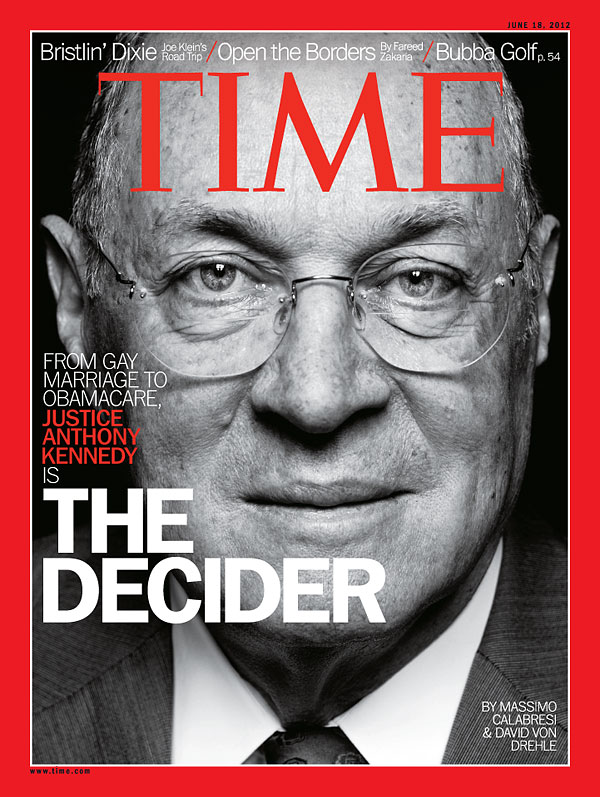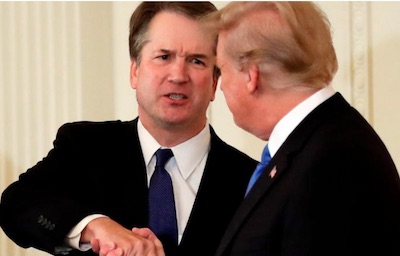 |
|
|
|
The Kavanaugh NominationThe Kennedy Vacancy
Ever since Richard Nixon became president in 1969, the Republican party has longed for establishing a Supreme Court that would render decisions consistent with its conservative worldview. Its effort, bolstered by fourteen appointments of justices by Republican presidents to only four by Democratic ones, always fell just short of achieving a reliable five-person majority. Justices Blackmun, Powell, Stevens, Souter, and even O'Connor and Kennedy, were all Republican appointees who disappointed the Republicans in varying degrees, just as President Eisenhower had lamented two of his greatest mistakes as president being the appointments of Earl Warren and William Brennan to the Court. Finally, the departure of Anthony Kennedy, the only justice even remotely positioned between two four-person blocs on the current Court--one conservative, one liberal--holds the promise of securing that Republican holy grail. As the June 18, 2018, Time magazine cover recognizes, Kennedy has long been the archetypical swing vote on the Court. In the past decade, 105 cases were decided by 5-4 votes pitting the liberal bloc of four versus the solid conservative bloc of four (Kennedy excluded), with Kennedy joining the majority group 90% of the time. This included joining the liberal bloc in 38 of the 48 cases in which they formed the majority. Still, Kennedy was more likely than not to side with the conservatives. He joined the conservative bloc in 56 of the 57 cases in which the conservative bloc prevailed. His voting with the liberal bloc carried the day for a number of cases dealing with gay rights, sentencing and criminal law matters, and race issues. It's no coincidence that the Trump administration is moving now to reverse policies in place that promote race-conscious guidelines in attempts to achieve diversity in higher education. Kennedy wrote the decision in Fisher v. Texas (2016) in a 4-3 voting outcome giving its constitutional blessing to University of Texas procedures allowing race to be considered as a factor in admissions. Perhaps most importantly, however, his departure may well signal the end of a Court willing even to consider partisan gerrymandering, a practice that undermines the very foundation of a representative democracy. The SettingFor such a momentous vacancy and one to be filled by a not very popular president (40% approval for now) with a razor-thin edge in the Senate (+2, reflecting the 51-49 Republican advantage), the setting score of around a -2 is not as imposing in its potential for controversy as one might expect from looking at the Setting chart. What the president has going for him is a compliant Senate (96% presidential support score), one that is intent on hastily filling the federal judiciary with only a modicum of scrutiny, having already filibuster-proofed their slim majority for any Supreme Court nomination by eliminating the 3/5 approval convention. The president must still proceed with some caution, being certain to nominate someone acceptable to the Republican senators because he may only get one chance prior to the midterm election. If the Democrats manage the near-impossible task of taking back the Senate, judicial appointments will take on a whole new character. The significance of this vacancy can hardly be understated. From the liberal perspective, any 5-4 decision of the Court favoring a liberal perspective could be overturned by an activist conservative Court. Look for Democrats and liberals to mount campaigns designed to pressure the handful of Republicans who might conceivably oppose a Trump nominee. Simultaneously, pressure to support a Trump nominee will be exerted against a fairly like number of Democrats who face reelection in normally red states . See the Nomination Setting page for more detail on the setting. The Nominee Moving quickly, President Trump has nominated Brett Kavanaugh, a 53-year-old judge from the DC Circuit Court who was
appointed to that position in 2006 by President Bush, confirmed by a 57-36 vote. That appointment was long in coming, his
nomination having occurred in 2003.
Democrats delayed the confirmation, opposing this Yale-educated conservative lawyer who had worked in the Kenneth Starr
inquiry into President Clinton
and subsequently in the Bush administration as the White House staff secretary. Kavanaugh's conservative credentials are
impeccable, and his legal training, experience, and reputation will almost surely pass muster with respect to his judicial
credentials. You may check out various descriptions of Judge Kavanaugh at the following sources.
Moving quickly, President Trump has nominated Brett Kavanaugh, a 53-year-old judge from the DC Circuit Court who was
appointed to that position in 2006 by President Bush, confirmed by a 57-36 vote. That appointment was long in coming, his
nomination having occurred in 2003.
Democrats delayed the confirmation, opposing this Yale-educated conservative lawyer who had worked in the Kenneth Starr
inquiry into President Clinton
and subsequently in the Bush administration as the White House staff secretary. Kavanaugh's conservative credentials are
impeccable, and his legal training, experience, and reputation will almost surely pass muster with respect to his judicial
credentials. You may check out various descriptions of Judge Kavanaugh at the following sources.
The InterimThe interim period is that time between the nomination and the vote in the Senate. It encompasses public reaction to the nomination, the activities of advocacy groups, press coverage, as well as the Senate Judiciary Committee hearing and subsequent committee activity. Use the links on the left to inform yourself about these various aspects of the process. What happens next for the nominee is a number of visitations to Senate leaders and members of the Senate Judiciary Committee. Simultaneously, the Judiciary Committee have the nominee complete a comprehensive questionnaire, and each senator on the committee will either assign a staff member to compile an independent file on the nominee or agree to work together with another one or more other senators to gather information in preparation for the hearing. A background check by the FBI is also standard procedure for such nominations. Senate Republicans and Democrats each have distinct preferred outcomes for this nomination. Republicans want to establish a reliably conservative Supreme Court they have sought for almost 50 years. The Democrats seek to prevent that outcome, preferably by defeating the confirmation, alternatively by delaying it past the mid-term election in the hope they might regain the Senate, continuing to postpone until the new Senate takes office in January. Both parties claim the moral high ground and accuse the other side of playing politics. They've got the politics part right, and understanding that can help you more properly evaluate their rhetoric. One side may actually occupy the moral and/or logical high ground. More importantly, you will likely believe that one side's outcome is better for the country than the other side. Politicians are great gymnasts, specializing in flips that justify opposite actions without breaking stride. In 2016, Senate Republicans refused to consider President Obama's Supreme Court nomination of Merrick Garland for 10 months, allowing the Court to limp along with eight justices for portions of two terms. Now, with the nomination of Kavanaugh, it's apparently imperative that the vacancy be filled as soon as possible in order that the Court begin the new term with a full membership. Efforts to claim the high ground in justifying their actions only revealed that, once again, in politics, all too often the end justifies the means. The SenateThe timeline set by the Republicans for the process, having a mid-September Judiciary Committee hearing, is pretty standard. The problem, however, was Kavanaugh's paper trail from his previous political work in Kenneth Starr's investigation of President Clinton, the George W. Bush administration, and his judicial record far exceeded that of any other nominee to be considered by the Senate. There was essentially no way to go through his record without delaying the process into October or even later. So, the Republicans could legitimately claim that more information had been provided on Kavanaugh than on almost any other nominee, a true statement. On the other hand, the Democrats could legitimately claim that the record on Kavanaugh was incomplete, especially missing sigificant elements of his work in the Bush administration, a true statement. I admit to a personal bias that it is more important to get it right than to get it fast. There is no need to confirm a Supreme Court nomination ASAP. It's more important to have a thorough vetting. The new twist in this nomination is the claim that Kavanaugh sexually assaulted a high school girl thirty-some years ago when he was a student at Georgetown Prep. Democrats have used, possibly even manipulated this claim, to support their efforts to delay any vote on the confirmation, as well as bolster their argument that Kavanaugh is unfit for this position. Republicans, aware that they cannot simply dismiss the claim, have argued that no investigation into the claim is needed other than a simple "he said, she said" hearing. It doesn't take a wizard to predict that the Republicans will find Kavanaugh's denial convincing (confirm ASAP) and Democrats will find the accuser's account credible, sufficient at least to require further investigation (delay past the midterms). Democrats were successful is getting one Republican on the Committee, Jeff Flake, to go along with their insistence that further investigation by the FBI could help determine the truthfulness of what occurred. Flake, one of the only Republicans willing to publicly criticize the president, voted to move the nomination to the Senate floor for consideration with the stipulation that an FBI inquiry, limited in scope and time would be conducted. Threatened with a loss of support for the confirmation by Flake, Lisa Murkowski, and possibly others, Republicans had no choice. Given, however, that the FBI takes orders from the president regarding the scope of any investigation and that the Senate Republicans are working with the president on the scope, there seems little doubt that the investigation will not be sufficiently broad to address the veracity of either Kavanaugh or Ford. It remains all about the end game, and the Republican strategy is to be able to say they have had an FBI investigation without actually having probed other aspects of Kavanaugh's testimony that might play into a "falsus in uno, falsus in omnibus" scenario. Without any corrobating evidence to support Ford, of which there is apparently none, Kavanaugh and friends need only stick to their denials. Other aspects of Kavanaugh's character, even his conspiratorial outburst against the Democrats, need not come into play. The Senate voted on October 6th 50-48 to confirm the nomination, one Republican voting present and one absent. One Democrat voted to confirm, all others to reject.
Updated on October 6, 2018, by George Watson |